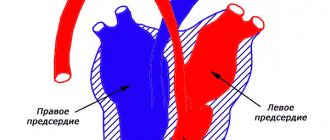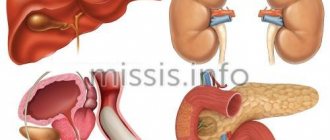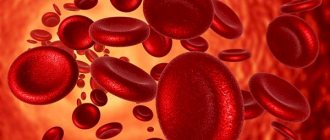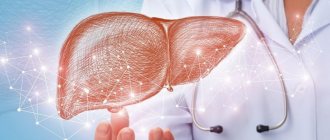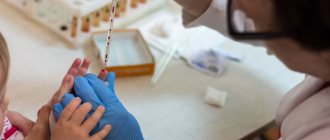Detailed description of the study
Normally, the thyroid gland, under the influence of the pituitary thyroid-stimulating hormone (TSH), synthesizes two hormones that affect the metabolism of the entire body: T3 (triiodothyronine) and T4 (thyroxine). The difference between them is that the first hormone contains three iodine molecules, and the second - four.
The biological activity of T3 is 3-4 times higher than T4. Both hormones enter the blood and circulate in it independently (free fraction) or by combining with blood plasma proteins. This study reveals the concentration of total T3 in the blood.
Total T3 is the total indicator of hormone fractions bound and unbound to plasma proteins in the blood. Most bound T3 is transported by albumins, prealbumins, and to a lesser extent by a special protein, thyroxine-binding globulin. Unbound (free) T3 molecules have greater biological activity than bound fractions.
The main functions of the T3 hormone include:
- Regulation of protein, fat and carbohydrate metabolism;
- Supports the physiological functioning of the heart (heart rate, blood pressure);
- Regulation of energy metabolism (acceleration of basal metabolism, maintaining body temperature);
- Participation in growth and development, especially in children: T3 accelerates growth, promotes the development of cognitive functions.
The physiological level of the hormones T3 and T4 (together with TSH) ensure optimal functioning of the thyroid gland - this condition is called “euthyroidism”. Disruption of the thyroid gland is accompanied by an increase (hyperthyroidism) or a decrease, and sometimes a complete loss of its function (hypothyroidism). Hypothyroidism and hyperthyroidism are nonspecific syndromes and can occur against the background of various diseases of the thyroid gland and the hypothalamic-pituitary system.
Symptoms of hypothyroidism may include:
- General weakness, drowsiness;
- Constipation (constipation);
- Slow heart rate (bradycardia);
- swelling of the face, limbs or trunk;
- Sensation of a “foreign body” in the neck due to an increase in the volume of the thyroid gland;
- Difficulty breathing and/or swallowing due to an increase in the volume of the thyroid gland;
- Delayed mental and physical development in children and sexual development in adolescents.
Signs of hyperthyroidism include:
- Headache;
- Anxiety, nervousness;
- Increased sweating;
- Rapid heart rate (tachycardia);
- High fatigue;
- Diarrhea;
- Sleep and eating disorders.
Determining the concentration of T3 in the blood, especially together with identifying the levels of T4 and TSH, makes it possible to establish a dysfunction of the thyroid gland and begin timely treatment.
Total triiodothyronine (T3 total)
Preparation for the study - on the eve of the study, it is necessary to exclude sports training and stress. Blood is taken on an empty stomach. 1 month before the study, it is necessary to avoid taking thyroid hormones, unless otherwise prescribed by an endocrinologist. 2-3 days before the study, avoid taking 131I and 99mTc and drugs containing iodine. Material for research: blood serum. Thyroid follicles secrete the hormone T4 several times more than T3. However, T3 exhibits a 10 times greater metabolic rate than T4 and exhibits more pronounced physiological and metabolic effects. Total T3 is characterized by seasonal fluctuations: the maximum level occurs from September to February, the minimum in the summer. By the age of 11-15, its concentration reaches adult levels. In men and women over 65 years of age, there is a decrease in total T3 in serum and plasma. In the euthyroid state, the concentration of the hormone may go beyond the reference values when the amount of the hormone bound to the transport protein changes. An increase in the concentration of this hormone occurs when its binding increases in the following situations: pregnancy, hepatitis, HIV infection, porphyria, hyperestrogenism. Indications for the purpose of the analysis: differential diagnosis of thyroid diseases; control study for isolated T3 toxicosis Norm for enzyme immunoassay: 21-45 years 1.0 - 2.8 nM/l Norm for chemiluminescence immunoassay: healthy adult men and women - 1.26 - 2.64 nM/l pregnant women 1 trimester - 1.86 - 4.73 nM/l 2nd and 3rd trimester - 2.33 - 5.56 nM/l children 1-3 years old - m: 1.94 - 3.89 nM/l; w: 2.12 - 3.33 nM/l 4-6 years - m: 1.72 - 3.62 nM/l; f: 2.27 - 4.01 nM/l 7-8 years - m: 1.92 - 3.99 nM/l; w: 2.2 - 4.15 nM/l 9-10 years - m: 1.75 - 3.27 nM/l; f: 1.67 - 3.1 nM/l 11 years - m: 2.17 - 3.38 nM/l; f: 2.03 - 3.92 nM/l 12 years - m: 2.14 - 3.61 nM/l; f: 2.24 - 3.36 nM/l 13 years - m: 2.06 - 4.02 nM/l; f: 2.03 - 3.67 nM/l 14 years - m: 1.98 - 3.38 nM/l; f: 1.8 - 3.27 nM/l 15 years - m: 1.72 - 3.44 nM/l; f: 1.61 - 3.04 nM/l 16 years - m: 1.77 - 3.36 nM/l; f: 1.64 - 3.06 nM/l 17 years - m: 1.17 - 2.52 nM/l; w: 1.2 - 2.89 nM/l 18-19 years old - m: 1.21 - 2.33 nM/l; g: 0.8 - 2.14 nM/l Increased total T3 level: hyperthyroidism; thyrotoxicosis; toxic goiter; isolated T3 toxicosis; thyroiditis; thyrotoxic adenoma of the thyroid gland; T4-resistant hypothyroidism; thyroid hormone resistance syndrome; TSH-independent thyrotoxicosis; postpartum thyroid dysfunction; choriocarcinoma; myelomas with high levels of IgG; nephrotic syndrome; chronic liver diseases, weight gain; systemic diseases; hemodialysis; taking amiodarone, estrogens, levothyroxine, methadone, oral contraceptives. Decrease in total T3 level: congenital hypothyroidism, euthyroid patient syndrome; uncompensated primary adrenal insufficiency; chronic liver diseases; severe nonthyroidal pathology, including somatic and mental illnesses. recovery period after serious illness; primary, secondary, tertiary hypothyroidism; artificial thyrotoxicosis due to self-prescription of T4; low protein diet; taking medications such as antithyroid drugs (propylthiouracil, mercazolil), anabolic steroids, beta-blockers (metoprolol, propranolol, atenolol), glucocorticoids (dexamethasone, hydrocortisone), non-steroidal anti-inflammatory drugs (salicylates, aspirin, diclofenac, butadione), oral contraceptives, lipid-lowering agents (colestipol, cholestyramine), radiocontrast agents, terbutaline.
References
- Hypothyroidism. Clinical recommendations. Association of Endocrinologists of Russia, 2021. - 38 p.
- Federal clinical guidelines for the diagnosis and treatment of thyrotoxicosis with diffuse goiter (diffuse toxic goiter, Graves-Bazedow disease), nodular/multinodular goiter, 2014. - 45 p.
- Encyclopedia of clinical laboratory tests / ed. WELL. Titsa. - M.: Labinform, 1997. - P. 461-465.
- Kumar, V., Abbas, A., Fausto, N. et al. Robbins and Cotran Pathologic Basis of Disease, 2014. - 1464 p.
T3 hormone test
Testing for triiodothyronine is carried out for the following indications:
- routine annual physical examination;
- the patient’s initial visit to the endocrinologist due to increasing symptoms of a malfunction of the thyroid gland;
- pathologies of the thyroid gland;
- monitoring the treatment of thyroid disorders;
- pregnancy;
- collecting analysis of the newborn, especially in cases where the mother has problems with the thyroid gland.
A test for the T3 hormone is also prescribed for people:
- with diabetes mellitus;
- with adrenal insufficiency;
- with pernicious anemia;
- elderly;
- women after childbirth;
- having an inherited predisposition to thyroid pathologies.
Normal for T3 general
When deciphering the results of the study, you need to take into account the fact that the equipment, reagents and standards of each laboratory may differ radically. In this regard, it is advisable to carry out diagnosis and treatment in the same medical institution.
Reference values for total T3
| Patient gender | Age | Total T3 indicator, nmol/liter |
| Female Male | 4 days – 12 months | 1,3 – 6,3 |
| Female Male | 1 – 12 years | 1,74 – 2,91 |
| Female Male | 12 – 15 years | 1,5 – 2,71 |
| Woman | 15 – 17 years old | 1,44 – 2,15 |
| Man | 15 – 17 years old | 1,45 – 2,39 |
| Female Male | 17 – 19 years old | 1,59 – 2,08 |
| Female Male | >19 years old | 0,89 – 2,44 |
Note:
the interpretation of the results is carried out exclusively by a specialist. In this case, the individual characteristics of the patient, medical history and the results of other studies are taken into account.
Factors that can distort the result
- Taking T3-increasing drugs: estrogens, tamoxifen, methadone, clofibrate, lithium drugs;
- Taking T3-lowering drugs: anabolics, androgens, aspirin, atenolol, amiodarone, cimetidine, furosemide;
- Pregnancy (increases performance);
- Myeloma (increases performance);
- Liver damage and dysfunction (increases indicators);
- Old age (low triiodothyronine levels are considered normal);
- Severe somatic diseases (low T3 syndrome with normal T4 levels).
T3 hormone is free and total - what is the difference?
A certain amount of triiodothyronine can be produced by gland cells in an already “ready” state, that is, with 3 iodine atoms. Once in the bloodstream, it communicates with transporter protein molecules. The hormone is transported through the vessels to the tissues that need it. But a small amount of triiodothyronine remains in the blood, unbound to protein molecules. This triiodothyronine is called “free T3 hormone.”
The hormone that remains free in combination with the one that is bound to proteins is defined as the total hormone T3. It is its quantity that is often indicative of questionable results of tests for free hormone, which are carried out to determine thyroid dysfunction in humans.
[Video] Doctor MD Mikhail Yurievich Bolgov, a surgeon of the highest category, will explain the difference between the total and free hormone T3. The features of its action and use in diseases of the thyroid gland are highlighted:
Which one to take - general or free?
The doctor decides which test is best. You can get a referral for it from a therapist, pediatrician or endocrinologist. The form will necessarily indicate the type of hormone.
Donating blood to check the level of free T3 is necessary for diseases of the thyroid gland, or to determine the effectiveness of hormonal therapy. An assessment of total T3 levels is required when diagnosing hypothyroidism or thyrotoxicosis. However, the best option is to take both tests.
How to prepare for the analysis?
Blood is taken to determine hormone levels in the morning, on an empty stomach. However, the patient is allowed to drink sweetened water.
If the patient has undergone surgery on the thyroid gland, is taking medications, or has recently completed a course of radiotherapy, then blood for the T3 hormone is taken no earlier than 14 days later.
To obtain an accurate result, you need to stop taking medications for 2 days. In particular, oral contraceptives can distort the data.
Difficulties in conducting analysis
Carrying out an analysis to detect the level of triiodothyronine is considered a rather complex procedure. Errors often occur in laboratories. You can think about these on your own if an additional test was carried out to identify the level of other thyroid hormones - TSH and T4. If the results obtained show that TSH is normal and the T3 hormone is elevated, then most likely an error has occurred. The unreliability of the analysis can also be judged on the basis of an increase in T3 and TSH, but normal T4 values. If such results were obtained, then it makes sense to double-check the data. This is due to the fact that when T3 increases, the TSH level decreases and T4 increases.
If the tests were carried out qualitatively and the results clearly indicate an increase in triiodothyronine, it is necessary to consult an endocrinologist.
T3 decreased
The decrease in triiodothyronine content occurs solely against the background of a decrease in the production of all other thyroid hormones.
This phenomenon is observed in several serious pathologies:
- hypothyroidism;
- endemic goiter;
- Hashimoto's thyroiditis;
- treatment with radioactive iodine;
- resection of part of the glandula thyreoide or the entire gland with a cavity;
- taking certain medications containing large amounts of iodine, such as cordarone and others.
The drug "Cordarone" can provoke a decrease in thyroid hormone levels
It should be noted that the drop in thyroid hormone levels does not occur chaotically. At first, there is always a decrease in T4 content, and then in triiodothyronine. There is a reason for this.
The activity of T3 is ten times higher than that of T4, therefore, with an acute need for T3, the mechanism of peripheral conversion of thyroxine to triiodothyronine is triggered. And only after T4 reserves are depleted, T3 begins to noticeably decrease.
If, nevertheless, T3, T4 total or free dropped significantly, symptoms of hypothyroidism begin to develop, manifested by:
- swelling;
- nausea;
- constipation;
- chilliness;
- hypotension;
- hypothermia;
- drowsiness;
- puffiness;
- general weakness;
- decrease in speech quality;
- increase in body weight;
- dry skin;
- decreased activity of thinking;
- menstrual cycle disorders;
- depression coupled with irritability;
- decreased potency, up to impotence;
- myxedema (in severe forms of pathology in adults);
- cretinism (with severe disease in children).
Impotence may also be based on a decrease in T3 levels
Also, the reasons why free T3 or total T3 decreases can be pathologies of the pituitary gland, such as hypopituitarism, empty sella syndrome, and others.
Tactics for reducing T3
Most often, treatment begins with the prescription of replacement therapy, synthetic analogues of thyroid hormones. But, in any case, if the T3 level decreases, self-medication is strictly prohibited; you should immediately seek advice from an endocrinologist.



